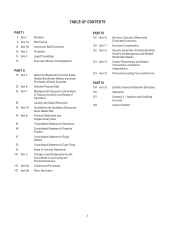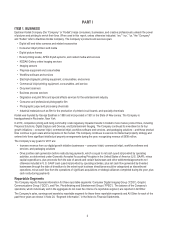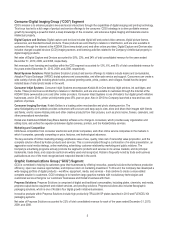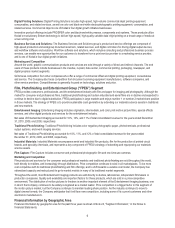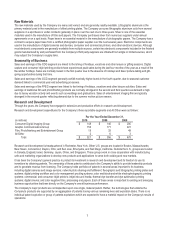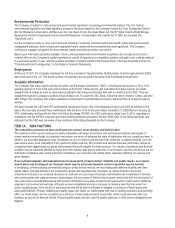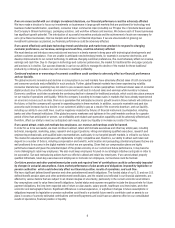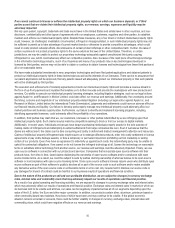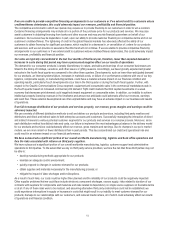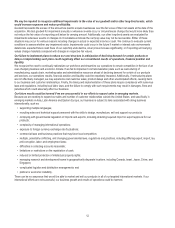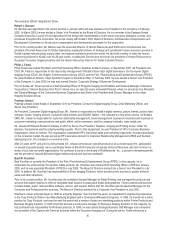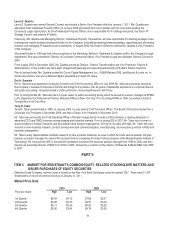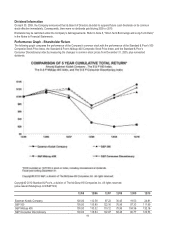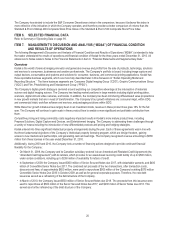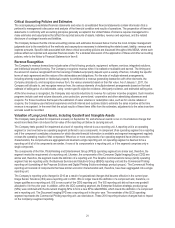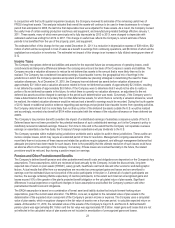Kodak 2010 Annual Report Download - page 15
Download and view the complete annual report
Please find page 15 of the 2010 Kodak annual report below. You can navigate through the pages in the report by either clicking on the pages listed below, or by using the keyword search tool below to find specific information within the annual report.
13
We are subject to environmental laws and regulations and failure to comply with such laws and regulations or liabilities
imposed as a result of such laws and regulations could have an adverse effect on our business, results of operations and
financial condition.
We are subject to environmental laws and regulations in the jurisdictions in which we conduct our business, including laws regarding
the discharge of pollutants, including greenhouse gases, into the air and water, the need for environmental permits for certain
operations, the management and disposal of hazardous substances and wastes, the cleanup of contaminated sites, the content of
our products and the recycling and treatment and disposal of our products. If we do not comply with applicable laws and regulations
in connection with the use and management of hazardous substances, then we could be subject to liability and/or could be
prohibited from operating certain facilities, which could have a material adverse effect on our business, results of operations and
financial condition.
Our inability to effectively complete, integrate and manage acquisitions, divestitures and other significant transactions
could adversely impact our business performance including our financial results.
As part of our business strategy, we frequently engage in discussions with third parties regarding possible investments, acquisitions,
strategic alliances, joint ventures, divestitures and outsourcing transactions and enter into agreements relating to such transactions
in order to further our business objectives. In order to pursue this strategy successfully, we must identify suitable candidates and
successfully complete transactions, some of which may be large and complex, and manage post closing issues such as the
integration of acquired companies or employees and the assessment of such acquired companies’ internal controls. Integration and
other risks of transactions can be more pronounced for larger and more complicated transactions, or if multiple transactions are
pursued simultaneously. If we fail to identify and complete successfully transactions that further our strategic objectives, we may be
required to expend resources to develop products and technology internally, we may be at a competitive disadvantage or we may be
adversely affected by negative market perceptions, any of which may have an adverse effect on our revenue, gross margins and
profitability. In addition, unpredictability surrounding the timing of such transactions could adversely affect our financial results.
Our substantial leverage could adversely affect our ability to fulfill our debt obligations and may place us at a competitive
disadvantage in our industry.
Our significant debt and debt service requirements could adversely affect our ability to operate our business and may limit our ability
to take advantage of potential business opportunities. A breach of any of the covenants contained in our Credit Agreement or our
other financing arrangements, or our inability to comply with the required financial ratio in our Credit Agreement, when applicable,
could result in an event of default under the Credit Agreement or our other financing arrangements, subject to applicable grace and
cure periods. If any event of default occurs and we are not able either to cure it or obtain a waiver from the requisite lenders under
the Credit Agreement and noteholders under our other financing arrangements, the administrative agent of the Credit Agreement
may, and at the request of the requisite lenders shall, and the trustee or the requisite noteholders under our other financing
arrangements may, and at the request of the requisite noteholders shall, declare all of our outstanding obligations under the Credit
Agreement and our other financing arrangements, respectively, together with accrued interest and fees, to be immediately due and
payable, and the agent under the Credit Agreement may, and at the request of the requisite lenders shall, terminate the lenders'
commitments under the Credit Agreement and cease making further loans, and if applicable, the agent and/or trustee could institute
foreclosure proceedings against our pledged assets.
Continued investment, capital needs, restructuring payments and servicing our debt require a significant amount of cash
and our ability to generate cash may be affected by factors beyond our control.
Our business may not generate cash flow in an amount sufficient to enable us to pay the principal of, or interest on, our
indebtedness, or to fund our other liquidity needs, including working capital, capital expenditures, product development efforts,
strategic acquisitions, investments and alliances, and other general corporate requirements.
Our ability to generate cash is subject to general economic, financial, competitive, litigation, regulatory and other factors that are
beyond our control. We cannot assure you that:
• our businesses will generate sufficient cash flow from operations;
• our plans to generate cash proceeds through the sale of non-core assets will be successful;
• we will be able to repatriate or move cash to locations where and when it is needed;
• we will realize cost savings, revenue growth and operating improvements resulting from the execution of our long-term strategic
plan; or
• future sources of funding will be available to us in amounts sufficient to enable us to fund our liquidity needs.
If we cannot fund our liquidity needs, we will have to take actions such as raising additional capital; reducing or delaying capital
expenditures, product development efforts, strategic acquisitions, and investments and alliances; selling assets; restructuring or
refinancing our debt; or seeking additional equity capital. Such actions could further negatively impact our ability to generate cash
flows. We cannot assure you that any of these remedies could, if necessary, be effected on commercially reasonable terms, or at all,
or that they would permit us to meet our scheduled debt service obligations. Certain of our debt instruments limit the use of the
proceeds from any disposition of assets and, as a result, we may not be allowed, under those instruments, to use the proceeds from


